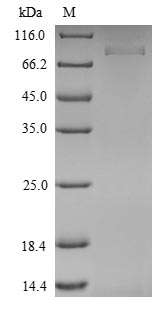Isthmin-1 (mouse) (rec.)
AG-40B-0215
Protein IDA2ATD1
Product group Proteins / Signaling Molecules
Overview
- SupplierAdipoGen Life Sciences
- Product NameIsthmin-1 (mouse) (rec.)
- Delivery Days Customer10
- CertificationResearch Use Only
- Concentration1 mg/ml
- Estimated Purity>95%
- Protein IDA2ATD1
- Protein NameIsthmin-1
- Scientific DescriptionIsthmin-1 (ISM1) was first identified as a gene expressed in the Xenopus midbrain hind brain organizer called isthmus, with a proposed role during early brain development. Isthmin-1 encodes a predicted ~50-kDa protein containing a signal peptide, a thrombospondin domain and an adhesion-associated domain. Isthmin-1 is important for embryonic and postnatal development. Growing evidence has shown that aberrant expression of Isthmin-1 can also affect the biological behavior of cancer. The Ism1 gene is conserved in mice and humans. A recent study showed that Ism1 is an adipokine that induces glucose uptake in human and mouse adipocytes. Ism1 is secreted by mature adipocytes and triggers a signaling cascade similar to that of insulin, regulating glucose uptake while suppressing lipid accumulation. Recombinant Isthmin-1 or overexpression of Ism1 causes a robust increase in GLUT4-dependent glucose uptake in cultured primary murine and immortalized human adipocytes as well as in primary human muscle cells and prevents insulin resistance and hepatic steatosis in a diet-induced obesity mouse model. Ablation of Isthmin-1 causes glucose intolerance and impaired insulin-stimulated adipocyte glucose uptake. Isthmin-1 suppresses de novo lipogenesis and increases protein synthesis in hepatocytes whereas Isthmin-1 knockdown in adipocytes reduces glucose uptake and insulin-dependent phosphorylation of protein kinase AKT at serine residue 473 (p-AKTSer473). Isthmin-1 signaling is dependent on PI3K and shares downstream phosphorylation targets with insulin signaling, such as p-AKTSer473, p-AKTThr308, p-ERK1/2Thr202/Tyr204 and p-S6Ser235/236. Isthmin-1 does not seem to act through the insulin receptor or the insulin-like growth factor 1 receptor; it is most likely to signal through another, yet to be identified, receptor tyrosine kinase. - Recombinant Protein. Mouse isthmin-1 (aa 30-461) is fused at the C-terminus to a His-tag. .Source: HEK 293 cells. Endotoxin content: 95% (SDS-PAGE). Isthmin-1 (ISM1) was first identified as a gene expressed in the Xenopus midbrain hind brain organizer called isthmus, with a proposed role during early brain development. Isthmin-1 encodes a predicted ~50-kDa protein containing a signal peptide, a thrombospondin domain and an adhesion-associated domain. Isthmin-1 is important for embryonic and postnatal development. Growing evidence has shown that aberrant expression of Isthmin-1 can also affect the biological behavior of cancer. The Ism1 gene is conserved in mice and humans. A recent study showed that Ism1 is an adipokine that induces glucose uptake in human and mouse adipocytes. Ism1 is secreted by mature adipocytes and triggers a signaling cascade similar to that of insulin, regulating glucose uptake while suppressing lipid accumulation. Recombinant Isthmin-1 or overexpression of Ism1 causes a robust increase in GLUT4-dependent glucose uptake in cultured primary murine and immortalized human adipocytes as well as in primary human muscle cells and prevents insulin resistance and hepatic steatosis in a diet-induced obesity mouse model. Ablation of Isthmin-1 causes glucose intolerance and impaired insulin-stimulated adipocyte glucose uptake. Isthmin-1 suppresses de novo lipogenesis and increases protein synthesis in hepatocytes whereas Isthmin-1 knockdown in adipocytes reduces glucose uptake and insulin-dependent phosphorylation of protein kinase AKT at serine residue 473 (p-AKTSer473). Isthmin-1 signaling is dependent on PI3K and shares downstream phosphorylation targets with insulin signaling, such as p-AKTSer473, p-AKTThr308, p-ERK1/2Thr202/Tyr204 and p-S6Ser235/236. Isthmin-1 does not seem to act through the insulin receptor or the insulin-like growth factor 1 receptor; it is most likely to signal through another, yet to be identified, receptor tyrosine kinase.
- Storage Instruction-20°C,2°C to 8°C
- UNSPSC12352202


